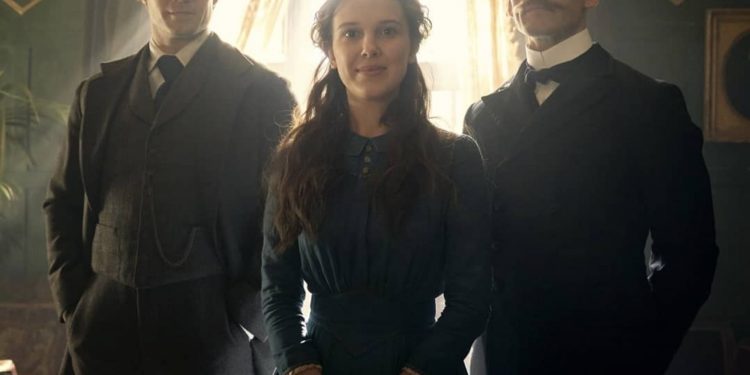Now, where to begin.
In many ways, Netflix’s recent adaptation of mystery crime’s darling Sherlock Holmes was destined for success. Led by a star-studded cast — Enola Holmes by Millie Bobbie Brown (Eleven in Stranger Things), Sherlock Holmes by Henry Cavill (Superman), and Mycroft Holmes by Sam Claflin (Finnick Odair in the Hunger Games) — superlative acting was almost a given.
And indeed, as of today, Enola Holmes continues to stand at number one on Netflix charts, in Singapore and worldwide.
The storyline (*spoiler alert*)
The film itself is based on a series of books by Nancy Springer (The Enola Holmes Mysteries), in which the viewer follows the adventures of Enola, Sherlock’s sister.
Enola spelled backwards is alone, and that’s what our protagonist is after her mother (played by Helena Bonham Carter) goes missing on the day of her sixteenth birthday. Ballsy and brilliant, Enola is no stranger to independent thinking, and decides to set off in search of her mother. From there, the story unfolds with arresting intimacy; Enola speaks directly to the camera, hence breaking the fourth wall and allowing the viewer on her sleuthing journey.
The role of Sherlock
While Sherlock plays second fiddle to his sister in this detective story, he nevertheless showcases his trademark deductive brilliance. He follows his sister’s footsteps in his own way — tracking down the same destinations but with a different set of clues.
For the most part, he’s still aloof and unfeeling, but it’s the closest to any expression of emotion that any Sherlock has ever portrayed. In a couple of scenes, Sherlock seems genuinely concerned for his sister’s wellbeing, even intervening with subtle guidance: “Sometimes you must dangle your feet in the water in order to attract the sharks.”
It’s a welcome change to Sherlock’s time-worn role as mastermind extraordinaire and fitting of his secondary character as older brother to a young sister.
The cinematography
Directed by Harry Bradbeer, the director of Emmy-winning series Fleabag, the audience gets several close-ups of Enola in mischief, derision, and poignant vulnerability. Much like Fleabag, the direct method of storytelling — from the protagonist herself — is packed with exposition and monologue weaved into strong narrative.
Interspersed is lustrous illustration of Victorian age London; one stunning design set features a colourful Covent Garden bustling with top-hats and farm-fresh produce. The lilt and bustle of old London is believable, as is the depiction of its countryside, marked by unkept green fields and arched railway bridges.
The verdict?
Despite its relatively predictable plot (as compared to other Sherlock franchises), Enola Holmes charms. As a teenage film, it knocks it out of the park. Millie Bobbie Brown as Enola is spirited and dynamic, with a self-assured air that delights the viewer and has them willingly staying to discover more.
Getting to solve the crime with Enola is good fun, as Enola is entertaining and quick-witted while feeding the clues to the mystery. Playing with elaborate word games and scribbled deductions, the story progresses closely aligned with the keen detail that makes Sherlock films so pleasurable to watch.
In a couple of scenes, we see the deft employment of a childhood toy — as a signal of comfort and assurance — first to Enola herself, then to Sherlock. In another, we see Enola visit a lead after working out a clever anagram with nothing but fleeting flashbacks to a secret meeting she once saw her mother take part in.
On feminism
Often, it’s like watching a female variation of Sherlock at work, and that is a brilliant affirmation that young women can prove themselves just as capable as men in an unequal world. It doesn’t, however, get much deeper than that.
There’s no deep dive into the other trappings of a patriarchal society; it would have been interesting to explore further the tropes a female might have faced in an 1884 investigation or the gender roles we tend to enact on ourselves (at one point, Enola was told “You’re getting emotional. It’s understandable but unnecessary.”).
But meant for the teenage set, it’s understandable. The plot is kept tight and light — just enough to nod to real-life suffragettes and modern feminism — but not so much that someone new to the topic would get overwhelmed.
Beyond the feminist theme
Enola Holmes is about carving your own path, and Enola does, with inspiring grace and breeziness. It’s a light-hearted watch that makes us excited for a sequel; who doesn’t want to follow the journey of a girl who belongs to no one but herself, and who refuses to be boxed in by social mores?
Enola herself, perhaps, sums it up best of all, saying, “Being alone doesn’t mean I have to be lonely. Mother never wanted that. She wanted me to find my freedom, my future, my purpose. I am a detective, I am a decipherer, and I am a finder of lost souls. My life is my own. And the future is up to us”.












